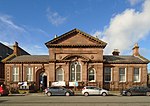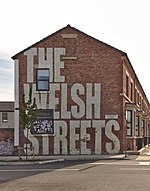Our Lady of Mount Carmel Roman Catholic Church, Liverpool
19th-century Roman Catholic church buildings in the United KingdomGrade II listed buildings in LiverpoolGrade II listed churches in MerseysideRoman Catholic churches completed in 1878Roman Catholic churches in Liverpool ... and 1 more
United Kingdom Roman Catholic church stubs

Our Lady of Mount Carmel is a Roman Catholic Church on High Park Street in Dingle, Liverpool. The church was built when the parish population had outgrown the nearby Church of St Patrick on Park Place. Initially, from 1866, a chapel dedicated to Our Lady of Mount Carmel was used in the school. The church proper opened on 21 July 1878. In December 2009 the church and the adjoining presbytery gained Grade II listed status.In 2001, the parish of Our Lady of Mount Carmel incorporated the nearby parish of St Finbar. The latter church had closed and was later demolished in 2003.
Excerpt from the Wikipedia article Our Lady of Mount Carmel Roman Catholic Church, Liverpool (License: CC BY-SA 3.0, Authors, Images).Our Lady of Mount Carmel Roman Catholic Church, Liverpool
High Park Street, Liverpool Toxteth
Geographical coordinates (GPS) Address Nearby Places Show on map
Geographical coordinates (GPS)
| Latitude | Longitude |
|---|---|
| N 53.386 ° | E -2.964 ° |
Address
High Park Street
High Park Street
L8 8AA Liverpool, Toxteth
England, United Kingdom
Open on Google Maps









